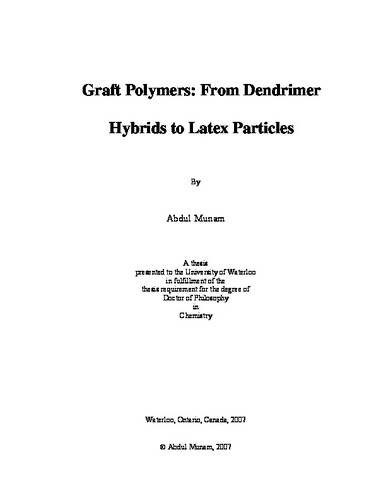| dc.description.abstract | The research presented focused on the synthesis and the characterization of graft polymers, of interest either as model systems or for large-scale applications. The materials selected as substrates for grafting reactions were carbosilane dendrimers, linear and branched polystyrenes, and cross-linked polystyrene latex particles. The synthesis of dendrimer-arborescent polymer hybrids was thus achieved by derivatization of the carbosilane dendrimers with dichlorosilane moieties and coupling with 1,4-polybutadiene side chains with Mn ≈ 1000. A second derivatization and coupling reaction with Mn ≈ 1500, 5000, or 30000 side chains yielded hybrid polymers with narrow molecular weight distributions (Mw/Mn ≤ 1.16). In the second part of the thesis, a procedure for the large-scale (100-g) synthesis of arborescent styrene homopolymers and copolymers incorporating poly(2-vinylpyridine) segments is presented. End-capping of the polystyryllithium chains with 1,1-diphenylethylene in the presence of LiCl, followed by the addition of 3 – 6 equivalents of 2-vinylpyridine per side chain, eliminated side reactions and led to grafting yields of up to 95 %. A systematic investigation of the solution properties of polyelectrolytes obtained by protonation of the poly(2-vinylpyridine) arborescent copolymers with a strong acid (trifluoroacetic acid) is also presented. The relative importance of the electrostatic repulsion and the elastic deformation forces on molecular expansion was investigated by examining the solution properties of the copolymers as a function of structure, protonation level, and the presence of salts in polar solvents (methanol, DMF, H2O). The viscosity of the arborescent copolymer solutions was also found to be much lower than for linear P2VP samples under the same conditions. In the last part of the thesis, the synthesis of model filler particles was achieved by grafting polyisoprene chains onto cross-linked polystyrene latex particles derivatized with acetyl coupling sites. These substrates, which can be viewed as an extreme case of a dense (hard-sphere) arborescent polymer structure, were used to investigate the influence of filler-matrix polymer interactions on the rheological behavior of filled polyisoprene samples. The influence of the filler structure on the rheological behavior of the blends was examined by dynamic mechanical analysis in terms of frequency-dependent complex viscosity, storage modulus, and damping factor. All the blends exhibited enhanced complex viscosity, storage modulus, and decreased damping factor values relative to the matrix polymer. | en |

